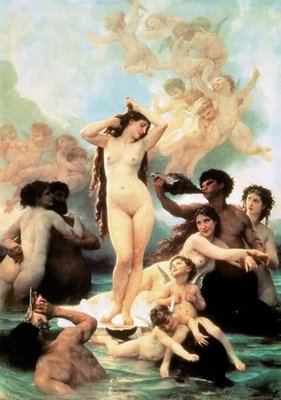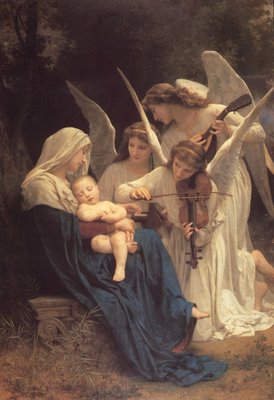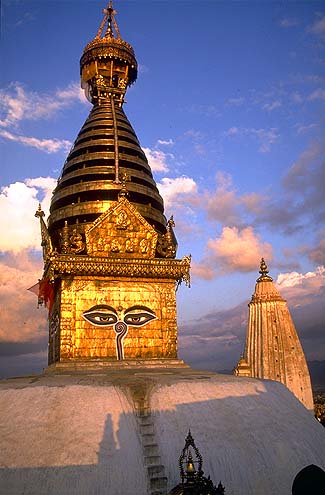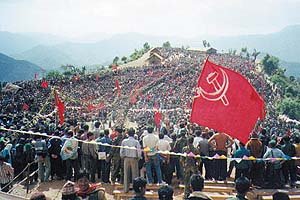
When Napoleon Bonaparte conquered France, he was not ignorant about the power of art to reflect his regime's ideals. He was also quite aware of art's ability to affect public opinion. He wisely chose Jacques-Louis David to head up the French Art world and gave him reign over the content, style and moral role that painting would play in the growingly oppressive Napoleonic empire. Jacques-Louis David was a great painter, and he devised a technique of working that would best serve the propaganda machine and methodology of the self-crowned Emperor.
Bonaparte realized that individual voices of dissent could grow and threaten his rule. It would become vital to neutralize these voices. David was employed to develop an approach to art-education and philosophy that would do just that. His most obvious tool was to eliminate the individual voice which comes from brushstrokes in a painting. When French artists created an artwork, therefore; it was imperative that they "erase" their individual voice. The school of David preached that smooth, flat surfaces were what all painters should strive to achieve and emulate. The school of David produced some gorgeously cool masterpieces which occupy a unique place in art history and the technical strength and allegorical impact of Napoleonic painting is beyond question. The works of these Napoleonic painters appear as polished, smooth, hard-edged and nearly photographic in their overall distribution of detail.
Folks, it took three generations of painters to free art from the strict cannons of smooth Napoleonic neo-classiscism. A fourth and fifth generation fought and died to bring the personal and expressive brushstroke to it's full articulation, purity and ultimately abstract power. Today, painting is seeing a resurgence. Realism, Impressionism, decorative applications, expressive solutions, International appropriation and even pop-culture cartoon stylistics are all choices available to the creative artist at the beginning of our twenty-first century. They are all valid, they are all widely practiced, and even marketable. How far we have come from the days when a single finger of art drove the entire body!
When The National portrait Gallery in Washinton D.C. announced last year that they would be hosting the Outwin Boochever Portrait Competition in 2006, artists of all backgrounds across America joyously submitted a portrait that reflected their relationship with their sitter. The event would be amazing. Perhaps it would be a survey of the multi-lingual artscape that our country has finally become. A return to portraiture as a revered contemporary subject could spell walls and walls of paintings dripping with expressive humanity. The task of creation and rush to submit to the event was embarked upon by well-over four thousand artists. The competition would be great, as only fifty or so paintings would be chosen by a distinguished jury for exhibition in time to coincide with the National Portrait Gallery's grand reopening on July 4th.
Now that the paintings have been chosen and the winner of the twenty-five thousand dollar first prize has been announced, it is of historical and artistic interest to see what has in effect, become the official art of the George W. Bush era.

When I clicked on the website of the National Portrait Gallery to
view the paintings shortlisted for the grand prize, I was met with a group of beautiful paintings that all had specific things in common: They appeared to be polished, smooth, hard-edged and nearly photographic in their overall distribution of detail...
"Sacre Bleu!" Shouts the ghost of the long-dead Napoleon Bonaparte. "Vive Le Emperor!"
A recent article in The Washington Post discussed the exhibition in terms of it's obsessive embrace of a single harsh painting style. Painting comes in many forms, and it seems odd that such a severe photo-dependent product be so highly showcased to the exclusion of so many other choices and possibilities. I know of a hundred or so portrait artists whose work was not chosen for the exhibition. Many of them were working in various expressive or "painterly" styles of realism. Most of them employed unblended brushstrokes in their creative process.
Let's face it, judging art is a lot like judging a bar-b-que ribs cook-off. One judge might like hickory smoke flavoring, while another goes for sweet Missouri style sauce. Some like meat falling off the bone, while other judges might go for firmer mouthfulls. In the end, personal taste must prevail, and be respected. It is still remarkable to me that such a large jury panel was so enamored with this Napoleonic aesthetic, when so many styles were submitted. What does this say about the image of the American human in our time? What does this say about the expectations Washington D.C. Curators have about contemporary painters?
It is also interesting to note that across the pond, The London National Portrait Gallery has opened their annual Open exhibition, which also features a select group of paintings based upon the same Napoleonic severity. Additionally, the lack of color in the London exhibition is interesting. Historically color use in art is equated with periods of freedom, vibrancy, passion and liveliness of a culture. What does this lack of color say about our times? Or the artist's perception of their role?
Certainly, to have such prestigious portrait exhibitions is a triumph in the wake of the modernist jihad that tried to erase the language of realism from the face of the earth in the last century. These are exciting events for lovers of art and creators of painting. Still, I like to ask the larger questions at hand.
Do we realist-artists ever question our own philosophies? Were we born to simply "paint as real as we can" ? Are our individual voices -our brushstrokes- distractions to be smoothed over? In the future, historians will look back to our time and perhaps see an amusing parallel to another epoch. They will marvel at the way cycles of politics echo cycles of art. They will note who marched in step with these cycles...and they will note who embraced the brushstroke. Let's beat these historians to the punch. Let's ask these questions now.





